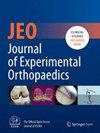Improvement in gait pattern after total knee arthroplasty for knee osteoarthritis
Abstract
Purpose
Knee osteoarthritis (KOA) leads to gait and balance deficiency, and to hinder activities of daily living (ADLs); all these factors may increase the risk of falls. Total knee arthroplasty (TKA) improves gait and balance; however, the effect of the contralateral knee's condition on this improvement has not been examined. This study evaluated the variation in gait pattern following TKA in relation to the different KOA levels or post-TKA conditions of the contralateral knee, examining the potential role of TKA in fall prevention.
Methods
This prospective study included 53 post-TKA patients at 1-year follow-up. The gait parameters of symmetry—namely gait ability, uniformity as an index of gait and balance, and steps to reflect the level of ADL—were measured using the application software installed on the smart phone. Repeated measures analysis of variance was used for statistical analysis. The gaits were compared between patients with cruciate-retaining (CR) and posterior-stabilized (PS) implants and those with different conditions of the contralateral knee.
Results
The preoperative uniformity, symmetry and steps were 59.0 ± 12.2%, 60.9 ± 12.9% and 50.4 ± 8.7, respectively. These gait parameters significantly decreased to 56.5 ± 12.2%, 58.5 ± 12.8% and 47.9 ± 8.6, respectively, 3 weeks after TKA; however, they significantly improved to 66.2 ± 10.7%, 68.5 ± 11.1% and 53.8 ± 4.9 1 year after TKA, respectively (p < 0.05). The variations of these parameters were similar between patients with CR and PS. Preoperative symmetry and uniformity declined with the progression of contralateral KOA grades, even after TKA. In contrast, the preoperative steps did not decrease with the increasing severity of contralateral KOA grades.
Conclusions
Gait parameters of KOA patients deteriorated with contralateral KOA and even after TKA over time. However, TKA could improve knee function, gait patterns and ADL, thereby potentially preventing falls.
Level of Evidence
Level III.


 求助内容:
求助内容: 应助结果提醒方式:
应助结果提醒方式:


